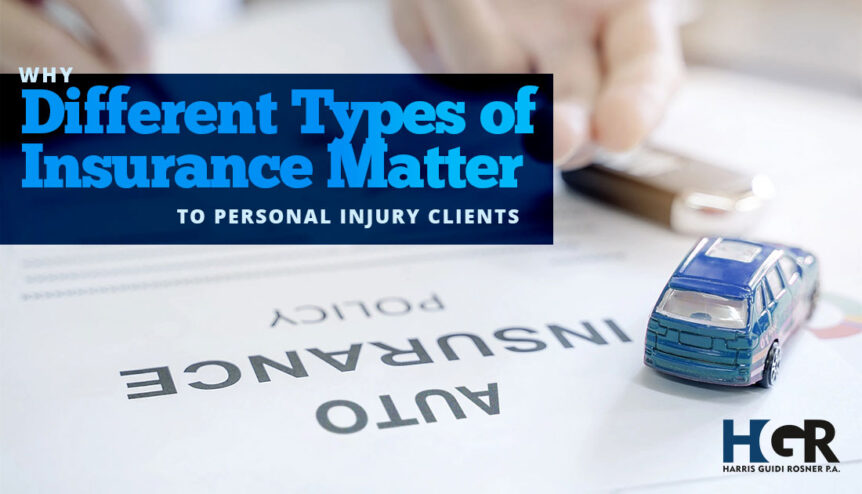When somebody is hurt in an accident, the first question we must address is “did someone act negligently or in a manner that they failed to take proper care resulting in the injury to another?” “Negligence” does not require that someone do something affirmatively wrong, such as texting and driving or running a red light, but rather that they drove in any manner that endangered and injured another. When a driver of a vehicle is negligent and causes an injury to another then they are subject to a personal injury claim by the injured party. Without insurance, the injured person, therefore, has a right to sue you for their injuries and make you pay for their damages directly out of the negligent driver’s own pocket. Car insurance with the proper coverages protects a negligent driver by insuring against this risk and requires the insurance company to provide the defense in the event that the negligent driver is sued for negligence resulting in the injury to another.
It is therefore very important for drivers to evaluate their insurance coverage before they are involved in an accident.
Unfortunately, people often come to us after an accident stating that they have “full coverage” on their car, believing that they are fully covered for their losses. Unfortunately, “full coverage” is not a technical or even defined term. It does not have a defined meaning and it could mean that only the property damage loss is fully covered, or the liability is fully covered, or even something else entirely. This is why it is important for people to learn that there are three major types of insurance for purposes of a personal injury matter, and they all play a different role.
Personal Injury Protection Coverage
First is Personal Injury Protection coverage, or PIP. PIP is a type of coverage required by all owners of a motor vehicle in the State of Florida. The vast majority of PIP policies provide $10,000 of coverage to injured drivers and pay 80% of all reasonable and necessary medical expenses until the limit is exhausted. If a person is hurt in an accident, no matter who is at fault, the first $10,000 of their recovery is paid through their own insurance. This allows them the opportunity to seek medical care without concern for who is at fault for the accident. While they will not make a financial recovery from this coverage, it does afford a significant benefit by allowing them to seek the medical care that they need.
Bodily Injury Coverage
The second type of insurance relevant to a personal injury claim is called Bodily Injury coverage, or BI. Bodily Injury coverage is the type of coverage that a driver purchases to protect themselves in the event that they are negligent and hurt somebody else. BI coverage is very important as the amount of insurance purchased is the amount that the insurance company will pay to protect them if a claim is made against them or they are sued. The insurance company will provide a defense to them up to the amount of their coverage.
Uninsured & Underinsured Motorist Coverage
Third, and I often tell my clients, most importantly, is Uninsured/Underinsured Motorist Coverage, often called UM Coverage. Unfortunately, many drivers on the road have either no Bodily Injury coverage to protect others, or very little. This means that they have not taken sufficient measures to protect another person in case they hurt them and the amount of insurance they have, if any, is too little to fully compensate an injured party for their injuries. If someone is hurt by a driver with too little or no BI, the injured person’s own UM coverage would then become available as an avenue for recovery of their losses for their injuries. It is worth noting that UM coverage also applies in the event that you are hurt by a driver who fled the scene and their identity cannot be obtained. The amount of Uninsured Motorist coverage that you buy is the amount of insurance you are buying to protect yourself, your loved ones, and the passengers riding in your vehicles in the event that they are injured by another driver with too little or no BI.
There are two additional important factors to consider regarding Uninsured Motorist Coverage. First, you can only purchase as much UM coverage as you purchase BI coverage. For example, if you want to buy $100,000 of UM coverage, you will also need to purchase $100,000 of BI coverage first. This is a requirement under Florida law as you can only insure to protect yourself for as much as you insure to protect others as well. Additionally, if you attempt to purchase Bodily Injury insurance and choose against purchasing Uninsured Motorist Coverage, you will have to sign a form called an Uninsured/Underinsured Motorist Coverage Rejection form or UM Rejection form. Much of the language of this form is prescribed by Florida Statute and requires the purchaser of insurance to explicitly choose a reduced amount or complete rejection of UM coverage if they choose to do so so that it cannot be claimed that they were not informed of the option to purchase UM coverage.
We always advise our clients to purchase as much UM coverage as they can possibly afford. We also advise that if they are not sure if they have it on their policy, to immediately contact your insurance agent or company as it can be added at any time. If you have any questions, please don’t hesitate to call HGR at 904-777-7777.
